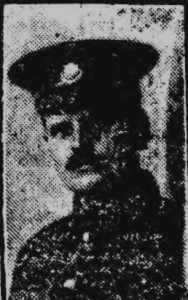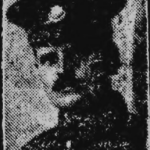
BORN HULL 1883. SON OF EDWARD DEYES (1855-1915) & ALICE ANN THOMPSON (1856-1922), OF 9, BEECH AVENUE, BEECH STREET, HULL (1911 CENSUS) AND 8, ARLINGTON TERRACE, CLIFTON STREET, HULL (WAR PENSION ADDRESS).
HE MARRIED AT HULL, IN 1907, AGED 24. HIS WIFE, EDITH JACKSON MITCHELL (1880-1973), LIVED AT 39, MASSEY STREET, HULL (CWGC ADDRESS). HE WAS FORMERLY EMPLOYED IN HULL CO-OPERATIVE STORES. HE WAS SECRETARY OF THE HULL TRADES AND LABOUR COUNCIL AND WORKED IN THE ‘SAILOR AND FIREMEN UNION’ OFFICES IN POSTERNGATE, HULL. HE WAS 34 YEARS OLD AND A MEMBER OF THE R.A.O.B.
HE ENLISTED IN THE HULL PALS DURING SEPTEMBER 1914. SERVED IN EGYPT AND FRANCE WITH THE 11TH EAST YORKSHIRE REGIMENT. TRANSFERRED AS SERGEANT IN THE 1ST EAST YORKSHIRE BATTALION. HE HAD SURVIVED THE ATTACK AT HENIN, ON 09/04/1917. WAS SHOT IN THE HEAD BY A SNIPER AND DIED INSTANTLY, ON 29/04/1917, AGED 34. (HULL DAILY MAIL, 02/06/1917)
HIS DEATH WAS REPORTED, WITH HIS PHOTOGRAPH, IN THE HULL DAILY MAIL ON 18TH MAY 1917. *
HE IS BURIED AT COJEUL BRITISH CEMETERY, ST. MARTIN-SUR-COJEUL. HIS GRAVE INSCRIPTION, READS, “LOVE AND REMEMBRANCE HE DIED THAT WE MIGHT LIVE EDE. AND SON LAURIE”.
Henin Cross – Beverley Minster
The cross commemorates all ranks of the 64th Infantry Brigade, which included the 1st East Yorkshires, 10th King’s Own Yorkshire Light Infantry and 15th Durham Light Infantry, who fell in the battle of Henin (2 km southeast of Arras), on 9th April 1917. It was a day when Commonwealth troops attacked the German lines on a very wide frontage, the northerly part of the operation being the Canadian Division’s celebrated capture of Vimy Ridge.
Facing Henin, the German positions were part of the notorious Hindenburg Line, the heavily armoured defences, behind which the German Army had withdrawn after the Somme battles of 1916. The 1st East Yorkshire Battalion was 1,000 yards from the Hindenburg, between Henin and Croisilles, with “C” company on the left, “B” Company Centre and “A” Company, on the right.
Dawn on 9th April 1917 was signalled by a terrific bombardment. The 1st East Yorkshire War Diary, written by Everard Wyrall, reported, “The shells shrieked and howled over the heads of the East Yorkshiremen, as they crouched in their trenches. Instead of the beautiful sunny weather of the previous day, a biting wind now swept the bare plain of Artois, a blinding snow storm adding its discomfort to the already adverse conditions. The shivering troops crouched in their trenches awaiting to go forward, for the 64th Brigade had been ordered not to attack, until certain objectives further north, had been captured by neighbouring divisions. Throughout the whole course of a cold and miserable morning the East Yorkshiremen waited, and at last, in the afternoon, orders came to attack.”
At about 3.50pm, under cover of a fresh bombardment, the East Yorkshires advanced in fine form, over no-man’s land, where the fields were by now thickly covered with snow. “C” Company was soon into the first trench of the Hindenburg Line, but suffered severe casualties by advancing too far and rushing into its own divisional barrage between the German first and second lines. The second German line was very strongly held and could not be captured. As neighbouring British troops had made little progress, the East Yorkshires were by the end of the day left “in the air” occupying part of the Hindenburg Line, but with no support on their immediate right or left. Fortunately there was no counter attack from the enemy, so they were able to consolidate their position throughout the night. Late next day, though, the Germans did launch an offensive and attacked both flanks of the battalion, the East Yorkshiremen had no alternative but to retire in good order, to their old “jumping off” lines.
Losses were heavy, but events subsequently proved that the 1st East Yorkshires were the only troops who had breached the Hindenburg Line in this sector on 9th April, the feat which prompted Sir Douglas Haig’s congratulations. The battalion had attacked with 19 officer and 521 other ranks and ended the operation with less than half that number (5 Officers killed, 8 wounded, 44 Other ranks killed, 149 wounded and 81 missing)
Shortly after the battle, out of the stout oak beams found amongst the debris of the ruined church at nearby Boisleux-au-Mont, the 64th Brigade pioneers and sappers made a simple wooden cross, as a memorial to the fallen. It was placed in the cemetery of Saint Martin, where it stood unharmed for the rest of war. It was replaced by a stone cross erected in Cojeul British Cemetery on Henin Hill and unveiled on 4th July 1931, by Brig. AJ McCulloch, a former commander of the 64th Brigade. Beverley Minster which had a long association with the East Yorkshire regiment agreed to receive the original wooded cross and it was laid up in the Soldiers’ Chapel on All Saints’ Day, on 1st November 1931.
